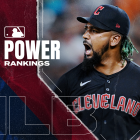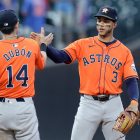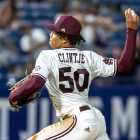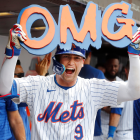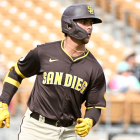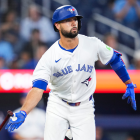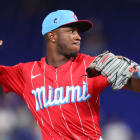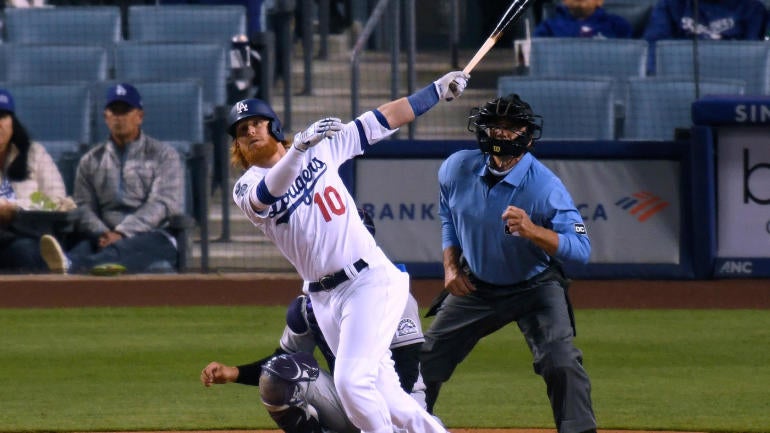
The 2021 MLB regular season is roughly three weeks old and although I know no one wants to hear it, it's still very early. How early? So early that four qualified hitters went into Tuesday's games hitting over .400. As a general rule of thumb, you can keep saying it's still early as long as someone is hitting .400.
Anyway, our weekly series breaking down various trends across the league continues Wednesday with a look at a veteran slugger having a hot start, one team's free-agent duds, and the league's home run rate. Last week we broke down Ronald Acuña Jr.'s excellence and Keston Hiura's problems with fastballs.
Turner's uncharacteristically huge April
It took a little longer than I expected, but the Los Angeles Dodgers and stalwart third baseman Justin Turner reunited over the winter. It never seemed all that likely he would sign elsewhere, so it was just a matter of agreeing to terms that worked for both sides. Turner took a two-year contract worth $34 million just as pitchers and catchers reported to spring training.
As expected, the defending World Series champions have been the sport's most dominant team in the early going, and Turner has been integral to their success. He owns a .381/.444/.730 batting line through the season's first two weeks, which is roughly 110 percent better than league average. Turner also leads the team with five home runs.
Turner has never been bad in April, though he is typically a slow starter, and it's usually not until the summer months that he really starts hitting the ball out of the park. Here are the numbers from 2014, the year Turner joined Los Angeles and remade his swing, though 2019 (ignoring 2020 because it was a weird year and they didn't play in April):
- March and April: .291/.364/.389 and 131 (!) plate appearances per homer
- All other months: .304/.384/.525 and 23 plate appearances per homer
Turner hit three March/April home runs total from 2014-19. He already has five this April. And again, Turner wasn't bad in previous Aprils. He just didn't hit for much power. The batting average and on-base percentage were more than respectable in the season's first month. It wasn't until he got a few week's worth of at-bats under his belt that he really took off though.
"I think it's just the law of averages," Dodgers manager Dave Roberts told reporters, including Mike DiGiovanna of the Los Angeles Times, last week. "April hasn't been good for Justin as far as slug, but he was due to slug a little bit in April. I'm happy that it's here in 2021. He looks really good at the plate. He's taking good at-bats, doing what he does."
The underlying numbers on Turner are in line with his career norms. He isn't chasing out of the zone, he isn't missing when he swings at pitches in the zone, the exit velocity is strong, he's hitting the ball in the air, and he's hitting to all fields. Turner is a hitting marvel who doesn't strike out excessively, walks a ton, and punishes the pitches he should punish.
Two of Turner's five homers were wall-scrapers, so the difference between five homers and a .730 slugging percentage, and three homers and two fly outs and a .603 slugging percentage, could be a gust of wind or a little humidity. The home runs happened though, and they helped the Dodgers win games. For Turner, this is the most productive April in his very productive career.
"I just feel good. I feel comfortable. I feel good with my work in the cage before the game," Turner told DiGiovanna. "I'm not trying to hit a bunch of home runs. I'm just trying to take good at-bats, hit balls hard somewhere, and a couple of them have gone over the fence so far, so that's nice."
(I can't help but wonder how the shortened 2020 season is impacting 2021. Several pitchers are throwing harder than ever and the 36-year-old Turner is having his best power-hitting April ever. Are veteran players feeling rejuvenated this season after getting extra time to rest and heal during the pandemic shutdown? And if so, will this level of performance last all year?)
Free-agent pitchers not helping Rays
Here's an unexpected stat: the Tampa Bay Rays have allowed the most runs in baseball this year (89). Usually they rank among the teams with the fewest runs allowed, but that is not the case three weeks into the new season. Keeping runs off the board has been an issue in the early going.
Over the winter the Rays spent money on starting pitching, which is not something they do often. From 2013-19, they signed only two free-agent starters to major league contracts: Nathan Eovaldi in Feb. 2017 (one year, $2 million) and Charlie Morton in Dec. 2018 (two years, $30 million). Tampa typically develops or trades for arms. Spending money is not the Rays' thing.
This past offseason the Rays signed four free agents with considerable starting experience to one-year major-league contracts: Chris Archer ($6.5 million), Michael Wacha ($3 million), Rich Hill ($2.5 million), and Collin McHugh ($1.8 million). Tampa let Morton walk and traded Blake Snell, and opted to spread the wealth around and bring in as many potential sources of innings as possible.
"We have a lot of youth. They're impressionable," Rays GM Erik Neader told reporters, including MLB.com's Adam Berry, in spring training. "These players that come in on one-year deals -- you never know what's after it -- but they each have an opportunity to leave lasting impressions on the talent that's here ... We've been the beneficiary of having some great veteran leadership the last few years and expect the same this year."
After the unusual pandemic season, investing in quantity was a sound strategy. Teams will have to monitor workloads as pitchers come off a truncated season, and the more potential innings-eaters you have, the better. The Rays aren't looking for 180 innings each from those guys. They'll be perfectly happy with 100-120 good innings apiece. Anything more than that is gravy.
Three weeks into the season, those four free-agent pitchers have contributed greatly to those 89 runs allowed. The Royals tagged Hill for four runs in three innings Tuesday night, giving that foursome a combined 7.02 ERA in the early going. The numbers:
| IP | H | R | ER | BB | K | HR | ERA | |
|---|---|---|---|---|---|---|---|---|
RHP Chris Archer | 4 1/3 | 7 | 4 | 3 | 1 | 6 | 0 | 6.23 |
LHP Rich Hill | 16 1/3 | 20 | 16 | 16 | 6 | 14 | 4 | 8.82 |
RHP Collin McHugh | 5 1/3 | 12 | 8 | 6 | 1 | 5 | 1 | 10.13 |
RHP Michael Wacha | 15 | 12 | 8 | 7 | 7 | 20 | 1 | 4.20 |
Total | 41 | 51 | 36 | 32 | 24 | 45 | 6 | 7.02 |
Ouch. That's 75 baserunners in 41 innings and it works out to a .313/.363/.515 opponent's batting line. That's more or less what Tim Anderson hit last season (.322/.357/.529). Those four pitchers have turned the 182 batters they've faced into the seventh-place finisher in last year's AL MVP voting. Even in a small sample, it's not good.
Archer (forearm tightness) and McHugh (back strain) are currently on the injured list after missing last season with injury, and that was the risk coming in. That they'd have trouble staying healthy and wouldn't perform when they were on the field. Hill, at age 41, may be nearing the end of the line. His strikeout and swing and miss rates have been way down the last two years.
The Rays have already used 19 different pitchers this season, the most in baseball, and before the end of the year they're likely to lean on youngsters Shane McClanahan, Brendan McKay, and Luis Patiño to contribute innings. McKay is on the mend following the shoulder surgery that sidelined him all last year, though he is expected to return at some point this summer.
Point is, the Rays went outside their comfort zone to sign those four free agents because they needed pitchers to, at the very least, help navigate the early part of the season until the kids arrived. They have yet to do that three weeks in. The performance has been poor and two of the four pitchers have already landed on the injured list.
Tampa gets the benefit of the doubt when it comes to pitching and deservedly so given the track record, though the early returns on their offseason pickups are a mixed bag at best. I doubt they want to push their young pitchers into action so soon, meaning the Rays may not have much choice but to hope the veterans turn it around, otherwise they'll remain atop the runs allowed leaderboard for the foreseeable future.
A lower home run rate, but at what cost?
In an effort to halt the sport's home run explosion, MLB made efforts to deaden the baseball this year, specifically by loosening "the tension of the first wool winding." The result would be a baseball that is less bouncy. That combined with 10 teams storing baseballs in a humidor (five existing teams plus five new ones this year) would bring the home run rate down, the league hoped.
Three weeks into the 2021 season, the new baseball appears to have had some impact on the league home run rate, though not a significant one. The April home run rate this year is lower than the April home run rate in 2019, the year all sorts of home run records were set, but it's also higher than the April home run rate from 2016-18. So, a lot of homers are still being hit.
Here are the April home run rates over the last few years. We're ignoring 2020 because no April baseball was played, and we're using home runs per balls in play because that is the most accurate measure. Home runs per game is skewed by seven-inning doubleheader games and the league's perpetually increasing strikeout and walk rates (i.e. fewer balls in play).
| March/April HR per BIP | Final regular season HR per BIP | |
|---|---|---|
2016 | 4.1% | 4.4% |
2017 | 4.5% | 4.9% |
2018 | 4.3% | 4.5% |
2019 | 5.3% | 5.5% |
2021 | 4.8% | ??? |
Weather absolutely plays a role in home run rates. The league home run rate typically peaks in July and August, when it's nice and hot outside. In April, it's still wet and cold and rainy in many MLB cities. The Pirates and Tigers were snowed out at Comerica Park just Tuesday night, in fact. April is when the home run rate is typically the lowest it will be all season.
In that sense, MLB's efforts to deaden the baseball have worked. The home run rate is down slightly, which theoretically creates an incentive to focus on contact and putting the ball in play. The problem? Contact is way down and strikeouts are once again at an all-time high. Here are the April contact and strikeout rates over the last few years, again ignoring 2020:
| March/April contact and strikeout rates | Final regular season contact and strikeout rates | |
|---|---|---|
2016 | 77.9% and 21.3% | 78.1% and 21.1% |
2017 | 77.5% and 21.6% | 77.5% and 21.6% |
2018 | 76.6% and 22.7% | 76.9% and 22.3% |
2019 | 75.8% and 23.3% | 76.2% and 23.0% |
2021 | 75.0% and 24.6% | ??? |
Generally speaking, what you see in April is what you're going to get all year when it comes to contact and strikeout rates. In the early going this year hitters are making contact with only three-quarters of their swings and striking out in roughly one-quarter of their plate appearances. This is on pace to go down as the most swing-and-miss and strikeout-heavy season in history.
Spin rates are up across baseball and pitch movement is up across baseball as well. Velocity is up too. There are indications the new baseball, which was intended to suppress home runs, has exacerbated the league's strikeout problem. Several pitchers said the new ball is easier to grip in spring training, and a better grip ostensibly equals more spin and more movement.
Padres starter Blake Snell has noticed the laces are thicker in the new baseball, allowing him to dig in his fingers so he can more easily throw breaking balls. He also noticed fly balls not carrying as much as they might have previously.
— Alden Gonzalez (@Alden_Gonzalez) March 9, 2021
“It’s definitely a different ball.”
"(Going) through four or five boxes of balls, but I would just say I've noticed they're consistent. I'm not seeing as much inconsistency in the seams," Yankees ace Gerrit Cole told reporters, including Dan Martin of the New York Post, in camp. "We were seeing seams that were pulled apart by the leather or a large seam or maybe even a deviation in the horseshoe, like a wiggle. I don't know how many I'd have to go through to find something like that before. I haven't come across anything strikingly weird, which is new."
In an effort to reduce home runs and emphasize contact, MLB may have inadvertently reduced contact by making a baseball that is easier to grip. Oh, and they succeeded at reducing home runs too, so the league went into Tuesday's games hitting .233/.311/.390. That's down from .252/.323/.435 in 2019 (.245/.322/.418 during the unusual 2020 season) and the .233 batting average would be the lowest in a season ever. The last time the league hit under .240 was 1968 (.237), the year before they lowered the mound.
MLB is good at nothing if not unintended consequences and their attempts at creating more action (i.e. more contact) may have led to the most strikeout-heavy brand of baseball in history, one with fewer home runs and fewer balls in play. More than one-third of all plate appearances end in a strikeout or a walk these days. That's too much, and I'm not overly confident MLB knows how to fix the problem. It feels like they're throwing things at the wall and hoping something sticks.














